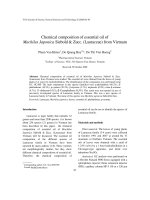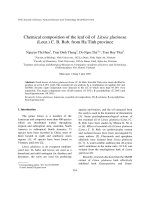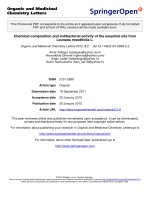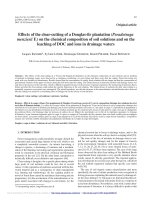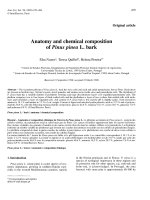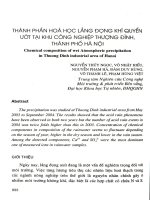Antimicrobial activity and chemical composition of the essential oils of mosses (Hylocomium splendens (Hedw.) Schimp. and Leucodon sciuroides (Hedw.) Schw¨agr.) growing in Turkey
Bạn đang xem bản rút gọn của tài liệu. Xem và tải ngay bản đầy đủ của tài liệu tại đây (163.58 KB, 7 trang )
Turkish Journal of Chemistry
/>
Research Article
Turk J Chem
(2013) 37: 213 – 219
ă ITAK
c TUB
doi:10.3906/kim-1204-72
Antimicrobial activity and chemical composition of the essential oils of mosses
(Hylocomium splendens (Hedw.) Schimp. and Leucodon sciuroides (Hedw.)
Schwă
agr.) growing in Turkey
ă
2 , Nevzat BATAN2 ,
Tayyibe Beyza CANSU1, Bă
uásra YAYLI1 , Turan OZDEM
IR
3
, Nurettin YAYLI1,4,
S
á engă
ul ALPAY KARAOGLU
1
Department of Chemistry, Faculty of Science, Karadeniz Technical University, 61080 Trabzon, Turkey
2
Department of Biology, Faculty of Science, Karadeniz Technical University, 61080 Trabzon, Turkey
3
Department of Biology, Faculty of Arts and Sciences, Rize University, 53100 Rize, Turkey
4
Faculty of Pharmacy, Karadeniz Technical University, 61080 Trabzon, Turkey
Received: 26.04.2012
•
Accepted: 20.12.2012
•
Published Online: 17.04.2013
•
Printed: 13.05.2013
Abstract: In the present work, the volatiles of mosses [Hylocomium splendens (Hedw.) Schimp. (Hylocomiaceae) and
Leucodon sciuroides (Hedw.) Schwă
agr. (Leucodontaceae)] have been investigated by GC-FID and GC/MS. Fifty-eight
compounds in the oil of H. splendens, representing 75.4%, and 41 compounds in the oil of L. sciuroides, representing
87.6%, were identified. The major components were found to be β -pinene (11.6%) and α -pinene (8.9%) in the oil of H.
splendens, and nonanal (26.8%) and heptanal (13.7%) in the oil of L. sciuroides. The essential oil of H. splendens was rich
in monoterpenes (30.8%), and aldehydes (49.9%) were the major constituents in the oil of L. sciuroides. The antimicrobial
activities of the isolated essential oils of the mosses were also investigated. The essential oil of H. splendens showed
antibacterial activities against Escherichia coli, Yersinia pseudotuberculosis, Staphylococcus aureus, Enterococcus faecalis,
Bacillus cereus, Mycobacterium smegmatis, and the fungus Candida albicans with minimum inhibition concentrations in
the range of 428–857 μ g/mL, respectively. The oil of L. sciuroides only showed activity against fungus C. albicans (711
μ g/mL).
Key words: Hylocomium splendens, Leucodon sciuroides, essential oils, GC-FID, GC-MS
1. Introduction
Essential oils and their constituents are widely used in cosmetics as fragrances, in medicine as parts of different
medical products, and in the food industry as flavoring additives. 1 The essential oils of mosses generate a
pleasant, sometimes distinct smell in the fresh state and have been used as traditional medicines. 2−4 There
are approximately 25,000 taxa of mosses around the world. 5−8 The genera of Hylocomium and Leucodon are
represented by 1 and 4 taxa 12,13 , respectively, in Turkey. Essential oils of mosses contain a great variety
of volatile metabolites, which are mainly mono-, sesqui- and diterpenes, and, in addition, various aliphatic
metabolites. 9−15 To our knowledge, there are no previous reports on the chemical composition and antimicrobial
activity of the essential oils of H. splendens and L. sciuroides, although the antibacterial activity of the solvent
extracts of H. splendens and L. sciuroides were mentioned and showed moderate activities. 16,17 Therefore, the
objective of the present study was to examine the chemical composition of the essential oils of H. splendens
∗ Correspondence:
213
CANSU et al./Turk J Chem
and L. sciuroides by gas chromatography–mass spectrometry (GC-MS) 9−15,18 as well as to evaluate the
antimicrobial activities of the essential oils.
2. Experimental
Hylocomium splendens (Hedw.) Schimp. was collected from Bor¸cka, Artvin, Turkey (at a height of approximately 293 m), in May 2011. Leucodon sciuroides (Hedw.) Schwă
agr. was collected from Yusufeli, C
¸ ıralı,
Artvin, Turkey (at a height of approximately 1524 m), in May 2011. The mosses were authenticated by Assoă
ciate Professor T. Ozdemir
immediately after collection. 6,7 Voucher specimens were deposited in the herbarium
ă
ă
of the Department of Biology (Ozdemir
and Batan 1501 and Ozdemir
and Batan 1502, respectively), Karadeniz
Technical University, Turkey.
2.1. Isolation of the essential oils
The fresh plant materials were separated and cut into small pieces. Crude essential oils of H. splendens
and L. sciuroides were obtained from the fresh mosses (approximately 55 g each) by hydrodistillation in a
modified Clevenger-type apparatus with a cooling bath (–12 ◦ C) system (4 h) (yields: 0.1% and 0.95% (v/w),
respectively). The obtained oils were dissolved in n-hexane (0.5 mL, HPLC grade), dried over anhydrous sodium
sulfate, and stored at 4–6 ◦ C in a sealed brown vial. One microliter of the essential oils was directly injected
separately into gas chromatography–flame ionization detector (GC-FID) and GC-MS instruments.
2.2. Gas chromatography
The capillary GC-FID analysis was performed using an Agilent-5973 Network System equipped with a FID
(supplied with air and hydrogen of high purity) and a split inlet. The chromatographic column used for the
analysis was an HP-5 capillary column (30 m × 0.32 mm i.d., film thickness 0.25 μm). Helium was used as
the carrier gas at a flow rate of 1 mL/min. The injections were performed in splitless mode at 230 ◦ C. Two
microliters of essential oil solution in hexane was injected and analyzed, with the column held initially at 60
◦
C for 2 min and then increased to 240 ◦ C with a 3 ◦ C/min heating ramp. The identity of each compound
was supported by comparing their retention indices (RIs) with published values. 9−15 The sample was analyzed
twice and the percentage composition of oil was computed from the GC peak areas without using correction
factors.
2.3. Gas chromatography–mass spectrometry
GC-MS analysis was performed using an Agilent-5973 Network System. A mass spectrometer with an ion trap
detector in full scan mode under electron impact ionization (70 eV) was used. The chromatographic column
used for the analysis was an HP-5 capillary column (30 m × 0.32 mm i.d., film thickness 0.25 μm). Helium
was used as the carrier gas at a flow rate of 1 mL/min. The injections were performed in splitless mode at 230
C. Two microliters of essential oil solution in hexane was injected and analyzed, with the column held initially
at 60 ◦ C for 2 min and then increased to 240 ◦ C with a 3 ◦ C/min heating ramp.
◦
2.4. Identification of components
RIs of all compounds were determined by the Kovats method using n-alkanes (C 6 –C 32 ) as standards. Identification of individual components was made by comparison of their retention times with those of available analytical standards (α -pinene, camphene, β -pinene, limonene, borneol, pulegone, n-tetradecane, n-heptadecane,
214
CANSU et al./Turk J Chem
n-nonadecane, n-eicosane, n-heneicosane, n-docosane, n-tricosane, n-tetracosane, and n-pentacosane purchased
from Merck and Sigma) and by computer search, matching mass spectral data with those held in the NIST
and Wiley library of mass spectra and literature comparison. 11−15,18 Component relative concentrations were
obtained directly from GC peak areas obtained with GC-FID.
2.5. Antimicrobial activity
All test microorganisms were as follows: Escherichia coli ATCC 25922, Yersinia pseudotuberculosis ATCC
911, Pseudomonas aeruginosa ATCC 43288, Staphylococcus aureus ATCC 25923, Enterococcus faecalis ATCC
29212, Bacillus cereus 702 Roma, Mycobacterium smegmatis ATCC 607, and Candida albicans ATCC 60193. All
extracts were weighed and dissolved in hexane to prepare extract stock solution of between 45,000 and 46,000
μg/mL. The antimicrobial effects of the substances were tested quantitatively in respective broth media by
using double microdilution and the minimal inhibition concentration (MIC) values (μg/mL) were determined. 19
The antibacterial and antifungal assays were performed in Mueller-Hinton broth or Tween 20 (Difco, Detroit,
MI, USA) at pH 7.3 and buffered in yeast nitrogen base or Tween 20 (Difco) at pH 7.0, respectively. The
microdilution test plates were incubated for 18–24 h at 35
◦
◦
C. Brain heart infusion broth (Difco) was used
20
for M. smegmatis, incubated for 48–72 h at 35 C. The MIC was defined as the lowest concentration that
showed no growth. Ampicillin (10,000 μg/mL), streptomycin (10,000 μg/mL), and fluconazole (2000 μg/mL)
were used as standard antibacterial and antifungal drugs, respectively. Hexane with dilution of 1:10 was used
as the solvent control.
3. Results and discussion
The mosses (H. splendens and L. sciuroides) were collected at different locations in Artvin, Turkey. Before
extraction, the mosses were carefully inspected for contaminations. Other plant material, conifer needles, and
soil were completely removed. The essential oils of the mosses (H. splendens and L. sciuroides) were obtained
by hydrodistillation method using a modified Clevenger-type apparatus. The obtained crude essential oils were
then investigated by GC-FID and GC-MS techniques. 9−15,18 The RIs, percentages, and chemical compositions
of the essential oils of H. splendens and L. sciuroides are listed in the Table.
Fifty-eight components were identified from the oil of H. splendens, representing 75.4% of the total
oil, and the major compounds were β -pinene, α -pinene, limonene, camphene, and heptadecene. n-Nonanal,
heptanal, tetradecanol, eicosane, and octanal were the main compounds of L. sciuroides out of 41 components,
representing 87.6% of the total oil.
The volatiles of most mosses are abundant in terpenes, aliphatic and aromatic aldehydes (α - and β pinene, camphene, p-cymene, n-heptanal, benaldehyde, n-nonanal, E,E-2,4-decadienal, E,Z-2,4-decadienal, benzaldehyde, E,E-2,4-nonadienal, phenylacetaldehyde, undecanal, etc.), aliphatic alcohols and ketones (decanol,
tetradecanol, hexadecanol, 3-octanone, etc.), and hydrocarbons (C 14 –C 25 , saturated). 9−15,18 In addition, a
great variety of terpenoid compounds were detected. Some of them could be readily identified by their characteristic mass spectra and seem to be almost ubiquitous in mosses. 12−15 Very common volatile constituents of
the essential oils of moss are α - and β -pinene, camphene, Δ -3-carene, sabinene, myrcene, camphor, limonene,
p-cymene, α -terpinene, and γ -terpinene, as well as borneol, bornylacetate, terpinen-4-ol, α -terpineol, pinocarvone, safranal, pulegone, carveol, longicyclene, and α -terpinylacetate. 9−15 We also observed the similar terpenes, aliphatic aldehydes, and hydrocarbons in the oils of mosses (Table). In the essential oil of L. sciuroides,
n-nonanal (26.8%) was found to be the major compound, which could be of use as a marker.
215
CANSU et al./Turk J Chem
Table. Identified components in the essential oils of H. splendens and L. sciuroides.
No.
1
2
3
4
5
6
7
8
9
10
11
12
13
14
15
16
17
18
19
20
21
22
23
24
25
26
27
28
29
30
31
32
33
34
35
36
37
38
39
216
Compounds
Monoterpenes
Tricyclene
α−Pinene c
Camphene c
Δ − 3−Carene
β−Pinenec
α−Phellandrene
Limonenec
p-Cymene
Monoterpenoids
α−Campholenal
Nopinone
Camphor
Pinocarvone
Borneolc
α−Terpineol
Safranal
Pulegonec
β−Cyclocitral
Carveol
Perilla aldehyde
Sesquiterpenes
Presilphiperfol-7-ene
Longipinene
Longicyclene
Panasinsene
β−Elemene
cis-α-Bergamotene
E-Caryophyllene
α−Guaiene
cis-Muurola-3,5-diene
trans- Muurola-3,5-diene
Ishwarane
γ−Muurolene
trans-Cadina-(1,6) 4- diene
Sesquiterpenoids
Caryophyllene oxide
Isolongifolonone
1,10-di-epi-Cubenol
(E)-2-hexylcinnamaldehyde
Diterpene
Kaurene-15
Diterpenoids
Manool
Terpenoid-related
3-neo-iso-Thujyl acetate
A
% Areaa
B
% Areaa
Exp.
RIb
Lit.
RI
0.5
8.9
4.2
11.6
0.6
4.7
0.3
0.5
0.8
-
925
936
950
975
976
1005
1027
1089
927
939
954
979
978
1003
1029
1091
0.3
0.3
0.8
1.5
0.6
2.1
0.6
0.2
0.2
0.3
0.3
-
1125
1138
1144
1161
1167
1186
1196
1212
1219
1232
1268
1126
1140
1146
1165
1169
1189
1197
1215
1221
1229
1272
0.4
0.3
0.9
0.6
0.2
0.2
0.4
0.2
0.3
0.3
-
1333
1356
1376
1385
1388
1417
1422
1443
1446
1460
1463
1479
1481
1337
1353
1374
1383
1391
1413
1419
1440
1450
1460
1467
1480
1477
0.8
0.4
0.2
0.6
0.4
1579
1613
1622
1748
1583
1613
1619
1750
-
0.9
1996
1998
0.9
-
2055
2057
3.3
-
1275
1276
0.2
0.3
0.3
CANSU et al./Turk J Chem
Table. Continued.
No.
Compounds
40
41
42
43
44
cis-Jasmone
Vestitenone
Ionone epoxide
β−Ionone
Hexahydrofarnesyl acetone
Hydrocarbons
Tetradecanec
Heptadecenec
Nonadecanec
Eicosanec
Heneicosanec
Docosanec
Tricosanec
Tetracosanec
Pentacosanec
Aldehyde
Heptanal
Benzaldehyde
Octanal
Benzene acetaldehyde
Octenal
Nonanal
(2E)-Nonenal
(2E,4E)-Nonadienal
Decanal
(2Z)-Decenal
(2E)-Decenal
(2E,4E)-Decadienal
Undecanal
(2E,4Z)-Decadienal
Others
3-Octanone
2-Pentylfuran
Acetophenone
Decanol
Benzophenone
3-Dodecanone
Dodecanol
Tridecanol
Tetradecanol
1-Methoxy, 4-(2-phenylethyl)benzene
Pentadecanol
Hexadecanol
Octadecanol
45
46
47
48
49
50
51
52
53
53
54
55
56
55
56
57
58
59
60
61
62
63
64
65
66
67
68
69
70
71
72
73
74
75
77
78
A
% Areaa
0.7
3.0
B
% Areaa
0.9
0.5
0.5
3.3
Exp.
RIb
1392
1450
1456
1487
1832
Lit.
RI
1391
1447
1454
1489
1835
3.4
1.8
1.6
1.1
1.7
1.1
0.3
0.7
0.4
4.6
0.5
0.9
2.0
0.7
1.7
1398
1696
1904
2001
2102
2200
2301
2400
2500
1400
1699
1900
2000
2100
2200
2300
2400
2500
1.2
0.8
1.2
1.5
0.2
0.7
0.7
0.2
1.4
13.7
1.4
2.6
1.1
0.6
26.8
0.5
1.3
0.2
1.2
0.5
904
962
998
1043
1056
1104
1160
1213
1199
1262
1264
1291
1305
1314
902
960
999
1042
1055
1101
1162
1215
1202
1264
1264
1293
1307
1317
1.0
1.6
0.1
0.3
0.2
1.3
0.3
2.3
2.3
0.4
0.8
0.3
1.7
8.5
0.4
0.4
0.5
-
984
989
1067
1193
1269
1388
1471
1576
1675
1755
1779
1877
2080
984
993
1065
1197
1270
1391
1471
1572
1673
1755
1776
1876
2078
217
CANSU et al./Turk J Chem
Table. Continued.
No.
Compounds
Monoterpenes
Monoterpenoids
Sesquiterpenes
Sesquiterpenoids
Diterpene
Diterpenoids
Terpenoid-related
Hydrocarbons
Aldehydes
Others
Total isolate
A
% Areaa
B
% Areaa
30.8
6.9
3.4
2.0
0.9
7.0
11.7
7.9
4.8
75.4%
1.3
0.3
1.2
0.4
0.9
5.2
10.8
49.9
17.6
87.6%
Exp. Lit.
RIb
RI
N.C.
7
2
10
1
9
4
4
1
1
1
0
3
4
8
7
9
11
7
10
58
41
A: Hylocomium splendens, B: Leucodon sciuroides.
a
% Area obtained by FID peak-area normalization.
b
RI calculated from retention times relative to that of n-alkanes (C6 –C32 ) on the nonpolar HP-5 column.
N.C.: Number of compounds.
c
Identified by authentic samples.
The qualitative and quantitative determination of essential oil of H. splendens and L. sciuroides showed
that monoterpenes (30.8%) were major constituents in the oil of H. splendens and aldehydes (49.9%) were the
main components in the oil of L. sciuroides. Generally, the number of volatile compounds present in the oil of
H. splendens is greater than that in L. sciuroides. In the literature 9−15 , chemical profiles of the essential oils of
the mosses showed large differences, as in our case, which can be explained by the locality, climatic conditions,
and the subspecies of the plant used.
The antimicrobial activities of the isolated essential oils were tested quantitatively in respective broth
media by using double dilution and the MIC values (μg/mL) 19,20 of 8 microorganisms (E. coli, Y. pseudotuberculosis, P. aeruginosa, S. aureus, E. faecalis, B. cereus, M. smegmatis, and C. albicans). The essential oil
of H. splendens showed moderate antibacterial activities against E. coli, Y. pseudotuberculosis, S. aureus, E.
faecalis, B. cereus, M. smegmatis, and C. albicans with MICs in the range of 428–857 μg/mL, but no antimicrobial activity was observed against the bacteria P. aeruginosa. The test extract of L. sciuroides showed only
antimicrobial activity against the fungus C. albicans (MIC: 711 μg/mL), and no antimicrobial activity was
observed against bacteria E. coli, Y. pseudotuberculosis, P. aeruginosa, S. aureus, E. faecalis, B. cereus, and
M. smegmatis.
Acknowledgments
ă
This study was supported by grants from the Karadeniz Technical University Research Fund (KTU-BAP
2010.11.004.7) and the State Planning Agency (DPT) of Turkey.
References
1. Singh, G.; Kapoor, I. P. S.; Pandey, S. K.; Singh, U. K.; Singh, R. K. Phytother. Res. 2002, 16, 680–682.
2. Ando, H. China Proc. Bryol. Soc. Jpn. 1983, 3, 124–125.
218
CANSU et al./Turk J Chem
3. Hart, J. A. J. Ethnophar. 1981, 4, 1–55.
4. Miller, N. G.; Miller H. Horticulture 1979, 57, 40–47.
5. Smith, A. J. E. The Moss Flora of Britain and Ireland, 2nd ed., Cambridge University Press, Cambridge, 2004.
6. Uyar, G.; C
¸ etin, B. J. Bryol. 2004, 26, 203–220.
7. Zoghbia, M. G. B.; Andrade, E. H. A.; Lobato, R. C. L.; Tavares, A. C. C.; Souza, A. P. S.; Concei¸cao, C. C. C.;
Guimaraesc, E. F. Biochem. System. Ecol. 2005, 33, 269274.
8. Kă
urschner, H.; Erda
g, A. Turk J. Bot. 2005, 29, 95154.
9. Sartaás, Y.; Sonwa, M. M.; Iznaguen, H.; Kă
onig, W. A.; Muhle, H.; Mues, R. Phytochemistry 2001, 57, 443–457.
10. Mues, R. In Bryophyte Biology; Shaw, A. J.; Goffinet, B., Eds.; Cambridge University Press, Cambridge, 2000.
11. Asakawa, Y. In Progress in the Chemistry of Organic Natural Compounds, Vol. 65; Herz, W.; Kirby, G. W.; Moore,
R. E.; Steglich, W.; Tamm, C., Eds.; Springer Verlag, Vienna, 1995.
ă cu
ă
12. Uá
ăncă
u, O.; Cansu, T. B.; Ozdemir,
T.; Karao˘
glu, S
¸ . A.; Yaylı, N. Turk. J. Chem. 2010, 34, 825834.
ă
13. Ozdemir,
T.; Yayl, N.; Cansu, T. B.; Volga, C.; Yayl, N. Asian J. Chem. 2009, 21, 55055509.
ă cu
ă
14. Cansu, T. B.; Uá
ăncă
u, O.; Kariman, N.; Ozdemir,
T.; Yayl, N. Asian J. Chem. 2010, 22, 72807284.
ă
ă cu
15. Ozdemir,
T.; Uá
ăncă
u, O.; Cansu, T. B.; Kahriman, N.; Yaylı, N. Asian J. Chem. 2010, 22, 7285–7290.
16. Kang, S. J.; Kim, S. H.; Liu, P.; Jovel, E.; Towers, G. H. N. Fitoterapia 2007, 78, 373–376.
17. C
¸ olak, E.; Kara, R.; Ezer, T.; C
¸ elik, G. Y.; Elibol, B. Afric. J. Biotech. 2011, 10, 12905–12908.
18. Adams, R. P. Identification of Essential Oil Components by Gas Chromatography-Mass Spectroscopy, Allured,
Carol Stream, IL, USA, 2004.
19. National Committee for Clinical Laboratory Standards, 19, 18-M26-A, NCCLS, Villanova, PA, USA, 1999.
20. Woods, G. L.; Brown-Elliott, B. A.; Desmond, E. P.; Hall, G. S.; Heifets, L.; Pfyffer, G. E.; Ridderhof, J. C.;
Wallace, R. J.; Warren, N. C.; Witebsky; F. G. Approved Standard. NCCLS 23, 18-M24-A, NCCLS, Villanova,
PA, USA, 2003.
219
